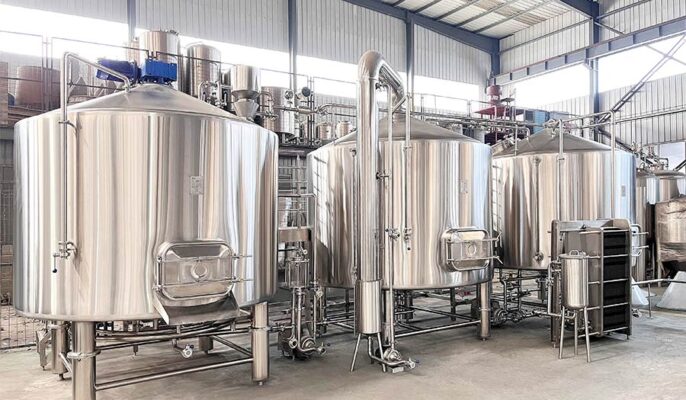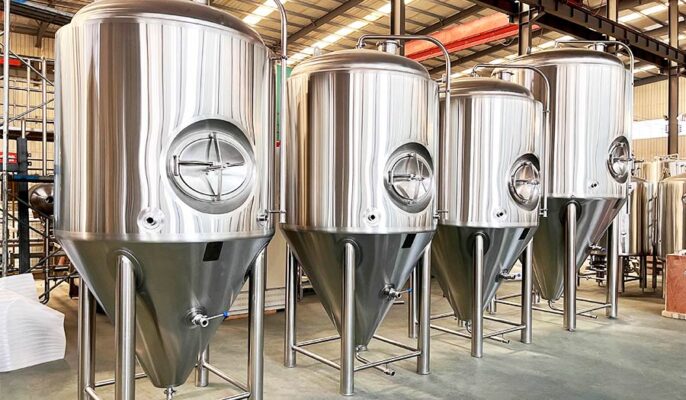Starting a commercial brewery is a tedious and exciting thing, and attrezzature per la produzione di birra commerciale is an indispensable and important part of it. As the global beer market continues to grow and diversify, the demand for commercial beer brewing equipment has also risen. As a professional brewery equipment manufacturer, we are committed to providing first-class beer brewing equipment to help companies improve production efficiency, optimize product quality, and meet market demand.
Che cosa è attrezzature per la produzione di birra commerciale?
Commercial beer brewing equipment is machinery and systems designed specifically for large-scale beer production. These equipment are suitable for medium to large breweries and can efficiently and stably complete various steps in the beer brewing process. Compared with home brewing or small craft brewing equipment, commercial beer brewing equipment has greater processing capacity, higher levels of automation, and stricter quality control standards.

Commercial beer brewing process
Grinding and mashing
The journey of beer brewing begins with malting, during which barley grains are carefully germinated, dried, and roasted to release the starch and sugars in them. This malt is then ground into a coarse powder called malt powder. The malt powder comes into contact with hot water in the wort barrel, where enzymes convert the starch into fermentable sugars to form sweet wort. Different wort-making methods, different temperatures, and times can meet the needs of different beer styles.
Boiling and hopping
The wort is poured into a pot and boiled vigorously. Hops are the flower bulbs of the hop plant, which are added at specific times to give the beer bitterness, aroma, and stability. Different hop varieties and addition schedules determine the uniqueness of each beer style. Used to give beer bitterness and aroma. Hops need to be stored in a dry and cool environment to maintain their freshness and effective ingredients.
Fermentazione
After the wort is cooled, it goes into the fermentation tank, where carefully selected yeast strains are added. This amazing microorganism devours the sugars, producing alcohol, carbon dioxide, and the unique flavor of the beer. The fermentation temperature and duration are strictly controlled, as they significantly affect the final flavor profile. During the secondary fermentation stage, the flavor of the beer develops further and the yeast and other sediments gradually settle. The maturation time can vary from a few weeks to a few months.
Imballaggio
Fill the filtered and clarified beer into bottles, cans, or kegs. The hygiene and sealing of the beer need to be ensured during the filling process. During the filling process, high-precision fillers and sealers are used to prevent the beer from coming into contact with air and maintain its freshness and taste.
Tipi di birra attrezzature per la produzione di birra
Wort barrel
A key piece of equipment in the beer brewing process is mainly used to handle wort (liquid wort after mash). The wort barrel is sometimes also called a “wort tank” or “wort tank”, and its function and design are crucial to ensuring the quality and production efficiency of beer. After the mash process is completed, the wort barrel is used to hold and handle the mash wort. The wort barrel can accept filtered liquid wort for further boiling or cooling.
Bollitore
The brew kettle is a key piece of equipment in the beer brewing process, used to boil wort (liquid wort after mash) and add seasonings such as hops. The design and function of the brew kettle directly affect the flavor, quality, and production efficiency of beer. The saccharified wort is heated to boiling point to kill microorganisms, eliminate the raw taste in the wort, and concentrate the wort. During the boiling process, phenolic substances in the wort are removed, thereby reducing the bitterness of the beer, and the aromatic and bitter components of the hops are released.
Filter Tank
The filter tank is used to separate wort (liquid) and malt residue (solid) from the saccharified malt mixture. The design and function of the filter tank directly affect the clarity and quality of the wort and is therefore one of the core equipment to ensure efficient and high-quality beer production. The main task of the filter tank is to separate the solid malt residue from the liquid wort in the saccharified mixture by physical filtration. A good separation process can obtain clear wort, reduce sediment, and improve the taste and appearance of the beer.
Vasca di fermentazione
The fermentation tank provides a sealed and controlled environment for yeast to ferment, convert sugars into alcohol and carbon dioxide, and generate various flavor compounds. Controlling the temperature, pressure, and time during the fermentation process ensures the flavor and quality of the beer… The design and function of the fermentation tank directly affect the taste, aroma, and overall quality of the beer.
Serbatoio luminoso
The bright tank is used to store the fermented liquid, ensure the stability and quality of the product, and prepare for subsequent packaging processing. The bright tank provides a maturation environment for the liquid to improve and perfect its flavor and taste. Proper storage conditions can promote the fusion and maturation of flavors and improve the overall quality of the product. Bright tanks play a key role in the beverage production process, and their design and function directly affect the stability and quality of the product.
Wort Cooler
Quickly cool the boiled wort to the temperature required for fermentation. Cooling is a key step in the brewing process, affecting the quality, flavor, and health of the beer. Effective cooling not only ensures the stability and clarity of the beer but also avoids bacterial contamination and flavor defects caused by delayed cooling.
Sistema di riempimento
Transfer beer from storage tanks to bottles, cans, or other containers, and ensure the efficiency and accuracy of the packaging process. An efficient filling system not only reduces product waste but also ensures the consistent quality of each bottle of beer. Modern filling systems usually integrate automation technology, with the function of accurately controlling liquid level, filling speed, and container sealing to improve production efficiency and product hygiene and safety. A good filling system design can reduce oxygen ingress, thereby avoiding beer oxidation, and maintaining its flavor and freshness, while improving the overall operation efficiency of the production line.
Sistema di pulizia
The cleaning system ensures that production equipment and pipelines are thoroughly cleaned and disinfected without disassembly. An efficient cleaning system can effectively remove residues, sediments, and microorganisms in the equipment, ensuring the sanitation and safety of the production environment and the stability of product quality. Through regular cleaning and disinfection, the cleaning system not only improves the operating efficiency of the production line but also extends the service life of the equipment, avoiding cross-contamination and product quality problems.

|
Attrezzatura |
Descrizione |
|
Bollitore |
Large stainless steel tank where malt is steeped in hot water to convert starches to sugar and extract flavors/colors from grains |
|
Tunnel di raffreddamento |
Separates sweet wort from spent grains through sparging process |
|
Filtro di mash |
Combines mash tun and lauter tun for efficient extract separation |
|
Birreria |
Collective term for brewhouse vessels – mash tun, lauter tun, kettle |
|
Fermentatore |
Closed, temperature-controlled vessels for fermenting beer |
|
Lavaggio fusti |
High-temp pressure washer for cleaning and sanitizing kegs |
FAQ
Che cos'è l'attrezzatura per la produzione di birra commerciale?
Commercial beer brewing equipment refers to the machinery and equipment used to produce large-scale beer, including wort barrels, fermentation tanks, filtration systems, wort coolers, filling systems, and cleaning systems. These equipment work together to ensure that the beer production process is efficient and meets quality standards.
Why is temperature control of fermentation tanks so important?
Temperature control is crucial to the fermentation process because different temperatures affect the activity of yeast and the fermentation rate, which affects the flavor and quality of beer. Proper temperature control can prevent the production of unpleasant flavors and ensure the stability and consistency of fermentation.
How does the filtration system improve the quality of beer?
The filtration system helps to clarify the liquid of beer by removing solid particles, sediments, and impurities from the wort, improving its appearance and taste. A good filtration system can also reduce sediments and improve the stability and shelf life of beer.




